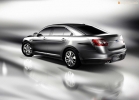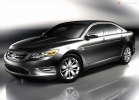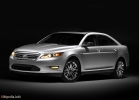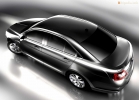Test drive Ford Taurus since 2009 sedan
Ford Taurus Sho 2010 against Mitsubishi Lancer Evolution MR Touring 2010
At first glance, compare these two adventurous. The nimble Spartan Mitsubishi Lancer Evolution on the one hand, leading his story from the omologation of the WRC races, and collected from everything that came to the arm of Ford Taurus Sho. On the other, Ford, according to rumors, owes his birth to amazing, but superfluous V6 from Yamaha, which had to be settled somewhere.But with a more detailed examination, this couple detecting amazing parallels in what they were for enthusiasts in the old days and, more importantly than now. They both were simple cars for transporting passengers who at their time became icons of rally after several injection of hormones. Then they were real cars for lover of racing. What have they become now?
We headed to the northeast so that, having traveled hundreds of kilometers along the straight highway and the winding roads of the central coast of California, to find out what they were made of, for whom and what was left of the original DNA.
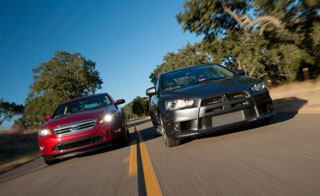
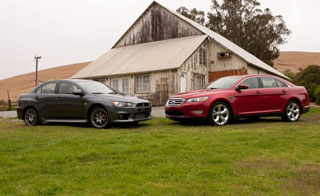
Mitsubishi Lancer Evolution Mr Touring 2010
My previous trip on the highway 229 passed behind the wheel of Ferrari F430, and as you know, my condition at that time was close to orgasm. Moreover, this state of consciousness is closely attached to that car that makes you feel the greatest racer of our time, unknown to the world. EVO has an innate ability to give just such sensations with a much less risk on such a wild and winding highway. The suspension is perfect, holding each of the four wheels in constant contact with the roadbed in any situation.
Standard Brembo brakes with honor withstand the load that would put many in an extremely difficult position, and a complex transmission completely erades the wrong ideas about the narrow specialization of all -wheel drive, designed exclusively for snow or dirt. Only the ability to leave any rivals far behind on narrow winding tracks in particular Taurus ShO can already be considered the main argument in favor of EVO for any enthusiast.
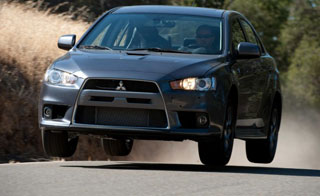 The Mitsubishi Evotations first appeared on the Japanese market in 1992 is currently produced in the 10th generation (known as EVO X) and is the most technologically advanced model. The legendary turbocharged 4G63 with an iron unit and a four-in-line cylinders, who worked in 9 previous generations, in 10th, replaced with a more light and powerful completely aluminum 4V11, also in an in-line four-cylinder. The volume remained the same, 2 liters, but a system for changing the phase of gas distribution of MIVEC at the release from the cylinders was added to it, complementing the same inlet system. Mitsubishi engineers thoroughly worked on eliminating the imbalance inherent in the in -line four -cylinder engines, and so that as a result it became possible to abandon the balancing shafts.
The Mitsubishi Evotations first appeared on the Japanese market in 1992 is currently produced in the 10th generation (known as EVO X) and is the most technologically advanced model. The legendary turbocharged 4G63 with an iron unit and a four-in-line cylinders, who worked in 9 previous generations, in 10th, replaced with a more light and powerful completely aluminum 4V11, also in an in-line four-cylinder. The volume remained the same, 2 liters, but a system for changing the phase of gas distribution of MIVEC at the release from the cylinders was added to it, complementing the same inlet system. Mitsubishi engineers thoroughly worked on eliminating the imbalance inherent in the in -line four -cylinder engines, and so that as a result it became possible to abandon the balancing shafts. At a power of 291 hp At 6500 revolutions per minute and a torque of 406 Nm by 4400, this small in -line EVO engine exceeds the Tweringurbial V6 ShO in terms of power to the working volume of more than 40 horses and 68 nm. And although the problem of insufficient torque has not disappeared into this low engine at low speeds, which forces many manufacturers to change the operating volume of the unit towards the increase, Mitsubishi solves this problem in a completely different way, using Twin Clutch Sportcht Transmission transmission (TC- SST). If in our test Evolution MR 2008, TC-SSTs found some shortcomings, then for EVO X 2010 they were adjusted by reprogramming a computer. Against the background of the five -speed mechanical gearbox, EVO GSR, the six -steady MR definitely wins thanks to the shorter main couples for each transmission for faster grabbing during switching, smooth transitions from one speed to another and additional transmission for more comfortable movement along the high -speed highway. It would be possible to scold Mitsubishi for the inability to choose a more harmonious name for her, but in fact we are delighted that the company has created a transmission that can, if necessary, increase the torque, which, moreover, turned out to be the best, in our opinion, in our opinion , a two -disc transmission in the market.
You can choose from three modes (Normal, Sport and Super Sport) using a switch located next to the gear selector, each of which is ideally configured for a particular driving manner. The dynamics of the Normal regime (ordinary) is practically unmistakable. In this mode, there are no excess failures in clutch and jerks at the start, the car goes very smoothly thanks to the converter of torque. Sport (sports) mode I chose it for my trip is characterized by more clear switches at high speeds, allowing you to switch earlier or lower the programs at my discretion using magnesium switches mounted to the steering column (in ShO for hand shift shifts it is necessary Pre -transfer the box to the appropriate mode of operation). Finally, Super Sport (Super Sport) should resort to in cases where you want to squeeze out all the power to the last horse (and start the Launch Control system). In a straight line in this mode, the car exchanges the first hundred in 4.6 seconds, and the quoter flies in 13.2 s, accelerating at the finish to 166.7 km/h. The engine is untwisted before cutting off in each gear, before switching to the next, and the transition to the lowered occurs after a split second after the revolutions come out of the optimal range in this mode, the car rides as if you set yourself the goal of driving the fastest circle or You had a very unsuccessful day.
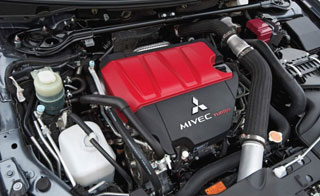 A detailed study of all aspects of the omnipotent all-wheel drive Super All-Wheel Control (S-AWC) global idea in itself. Other drive systems for all four wheels, such as Sh-AWD in Acura or Xdrive, in BMW, use incredibly cunning devices, but cars of these brands do not cause so thrill as all-wheel drive EVO (exception here, perhaps, is only the ATTESA E- system TS with Nissan GT-R).
A detailed study of all aspects of the omnipotent all-wheel drive Super All-Wheel Control (S-AWC) global idea in itself. Other drive systems for all four wheels, such as Sh-AWD in Acura or Xdrive, in BMW, use incredibly cunning devices, but cars of these brands do not cause so thrill as all-wheel drive EVO (exception here, perhaps, is only the ATTESA E- system TS with Nissan GT-R). In this case, the driver’s intention is perhaps a key concept, and if you intend to cut off the turn, then EVO will do this without any objections. The main difference between this EVO approved for the American market, as well as the two previous generations, is the presence of a target control system (the fourth -generation first presented on Japanese vehicles), which operates with the help of a rear magnetic differential, individual control of the inhibitory effort and a set of sensors that allow you to follow The direction of movement in real time. Extremely fast transfer of the power of the steering wheel provides high accuracy of the entrance to the turn, and the mechanical parts rotate and create the necessary force on the steering wheel, while the suspension remains perfectly balanced. Great entertainment.
The S-AWC all-wheel drive system, tied on a central differential controlled by a computer, an active stability control system and an improved Mitsubishi brake control system called Sports ABS, is the most modern and effective among the similar ones.
Mitsubishi Evo X 2010 of the model year is also available in the MR Touring configuration. It is less extrovert than the standard, known to the public for the fourth film Furious. The Touring model is equipped with a glass hatch with an electric drive (an aluminum roof was replaced by steel), heated leather seats instead of the usual leatherette, a spoiler on the lid of the trunk, instead of an anti -wing, strongly preventing the rear view, and better soundproofing, which is very high noisy tires Yokohama.
Among other changes that you can note with the naked eye (for all models of 2010), there are wider and aggressive door pads, which, in addition to giving the appearance of an additional attractiveness, prevent the preparation of paint when the sides with small pebbles are contacted, and the dashboard display from the dashboard from The backlighting of a different color that creates a sensation of higher quality in the cabin and helps to justify the cost of the Touring configuration. A similar, more mature, approach to Evo made us think that this Mitsubishi Blood relative of Sho.
So approaching the ideal Evo still has a couple of disadvantages. A small trunk (without the ability to place part of a large -sized cargo in the salon) automatically moves large things to the trunk on the roof. In addition, he has the largest fuel consumption among cars with 4-cylinder engines in this class and there is no telescopic adjustment of the steering column (for me, for example, this is a matter of personal geometry). For the sake of a car worthy of the highest praise, you can close your eyes on these little things.
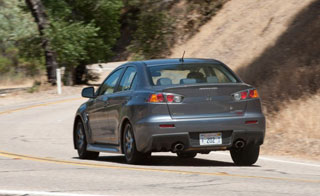
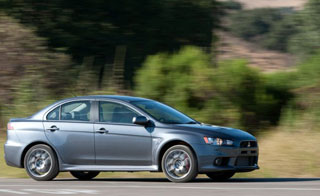
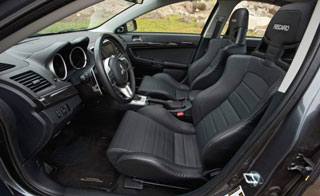
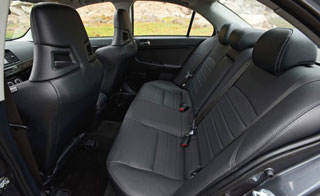
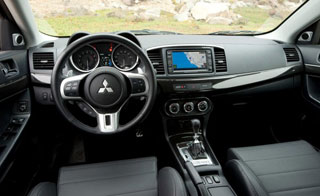
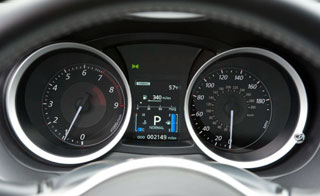
Ford Taurus Sho 2010
In 1989, Ford opened a new niche by releasing a dynamic Taurus model on the market. A completely new car at that time demonstrated an unexpectedly high quality suspension in combination with a technological reserved engine and a chic salon based on a vegetable sedan, which made it acceptable in cost and made it possible to compete with BMW, which cost the consumer more than tens of thousands of dollars more expensive. The recognition of only among a small group of enthusiasts who closed their eyes to the traditional shortcomings of the front -wheel drive, the first generation of ShO from the V6 in 1996 was supplemented by a more chic option with V8, before swaying into oblivion in 1999, turning into a cheap car from the rental by that time.
However, the new Taurus ShO is unlikely to be waiting for the same fate. Since now the role of simple hard workers for daily trips is assigned to crossovers and minivans, Ford decided to promote his flagship in the line of full -sized sedans in the luxurious car segment and reincarnated the SHO version. This is an old ShO with many pleasant additions.
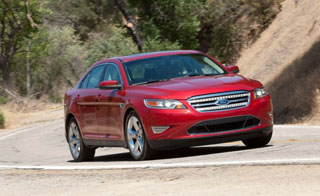 So, unlike the athletic Mitsubishi Evo, Taurus Sho focuses on 10-position adjustment of the front seats with servo, heating, cooling and a built-in massager, not to mention far from modest dimensions. If you put these two cars nearby, then Sho will finish over Evo, like a lock above the hut, thanks to a longer wheelbase (20 cm) and proportions resembling a low greenhouse. If we compare their total dimensions, then Sho will be longer than EVO by 65.8 cm, higher by 6 cm and wider by 12.45 cm.
So, unlike the athletic Mitsubishi Evo, Taurus Sho focuses on 10-position adjustment of the front seats with servo, heating, cooling and a built-in massager, not to mention far from modest dimensions. If you put these two cars nearby, then Sho will finish over Evo, like a lock above the hut, thanks to a longer wheelbase (20 cm) and proportions resembling a low greenhouse. If we compare their total dimensions, then Sho will be longer than EVO by 65.8 cm, higher by 6 cm and wider by 12.45 cm. It is logical that EVO will lose in the amount of luggage and passengers. In ShO, four adults (with luggage) are freely accommodated by our team repeatedly, because every time it reaches the trip by the whole company for lunch, we always chose ShO. In addition, the large plush seats of Taurus and an endless number of pleasant little things completely overshadow the Spartan front seats EVO and its microscopic rear sofa.
Sounds from outside, or rather, their absence, another indisputable victory Sho. Taurus doors are closed tightly, with a solid heavy sound, and at high speed they make a light unobtrusive whistle, unlike EVO, the acoustic accompaniment of which resembles a tin jar.
Of course, solid dimensions and all these ergonomically ideal spinning handles cause a large weight of more than 385 kg of amenities, plus a servomotor. But most of this weight is used wisely, because it is a tight suspension, and all -wheel drive, and sonorous V6. Having at the disposal of 3.5 liters, or 3490 cubic meters. SM of a working volume, 24-valve 6 cylinder SHO power unit with an aluminum unit is successfully complemented by an effective combination of a direct fuel injection system and double turbocharging, which Ford calls Ecoboost. But they are impressive not obtained as a result of 365 horses, but an incredible amount of torque, available in Super mode, and this is what distinguishes SHO from Evo with its wandering row. And do not forget about the smoothly triggered steering speed switches that sacrificed the transmission speed for the sake of grace (this is especially obvious after the grinding switches of the EVO multi -mode transmission).
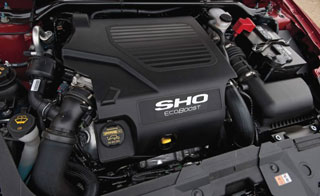 Despite all the charm of the basic configuration, the car acquires a real charm with a package of Performance Package options, characterized by a higher transmitting number invigorating tonic in this excreted cocktail. Surprisingly, shorter transfers did not improve Sho acceleration from 0 to 100 km/h (due to an additional transmission change), but on the quota it played a role, improving the result by 0.3 seconds and allowing the machine to develop a more speed at the finish line 3.5 km/h. More sports summer 20 -inch tires and improved front brake pads are two more characteristics of the Performance Package options package, to which you can safely add a more accurate calibration of the electronic steering wheel amplifier and the possibility of completely disconnecting the clutch and stabilization control systems. The combination of these characteristics provided an increase in 0.06G in the test for lateral acceleration, added 3.3 km/h in slalom test and reduced the braking distance from 100 km/h by 20.32 cm, and from 128 km/h to 38.1 See these improvements have become a final stroke in honing the SHO dynamics, without revealing the obvious shortcomings.
Despite all the charm of the basic configuration, the car acquires a real charm with a package of Performance Package options, characterized by a higher transmitting number invigorating tonic in this excreted cocktail. Surprisingly, shorter transfers did not improve Sho acceleration from 0 to 100 km/h (due to an additional transmission change), but on the quota it played a role, improving the result by 0.3 seconds and allowing the machine to develop a more speed at the finish line 3.5 km/h. More sports summer 20 -inch tires and improved front brake pads are two more characteristics of the Performance Package options package, to which you can safely add a more accurate calibration of the electronic steering wheel amplifier and the possibility of completely disconnecting the clutch and stabilization control systems. The combination of these characteristics provided an increase in 0.06G in the test for lateral acceleration, added 3.3 km/h in slalom test and reduced the braking distance from 100 km/h by 20.32 cm, and from 128 km/h to 38.1 See these improvements have become a final stroke in honing the SHO dynamics, without revealing the obvious shortcomings. In this configuration, Sho is a magnificent, luxurious car. Excellently feeling on a wide highway thanks to smoothly dosed power, excellent clutch and muffled personality, it easily swallows huge distances. At a consumption of 19 l/ 100 km on the highway and a tank volume of 72 l Sho allows you to make a minimum of refueling stops. The cruise control system based on the radar allows you to support one of three pre-installed distances, automatically reducing and resuming speed. You can only steer. The navigation system (option) and a powerful electronics system will notify you of the location of the nearest gas stations and cafes, and even about the price level and an environment in real time (can help when moving in city jungle).
Fatigue, even in the most general sense, seems to be a funny idea in this new ShO. In addition to the mass of free space inside this full -sized sedan, some additional equipment slightly changes our idea of \u200b\u200bequipping a sports sedan. The glass hatch with an electric drive and an audio system with 12 speakers are unlikely to surprise anyone, but sorry heating the rear seats, there is no leather sofa with the cooling system here and sunlight visors for passengers in the rear seat in a sports car are extremely rare.
When the road becomes interesting, the steering wheel speed switches provide additional control over the situation and confident behavior of the chassis. Sho is unlikely to master the figures of the highest aerobatics available to EVO, although it easily cuts turns, the mountain serpentine is without a doubt, without frightening the narrow winding paths. Only under indecent pressure, the suspension finally gives slack, the front wheels begin to grab the road surface intensively, but it also copes with this, reducing the speed. True, during this time passengers manage to frantically check whether they are well fastened.
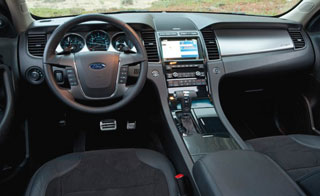 On city roads, Sho continues to surprise us with unexpected electronic tricks. A striking example is the Cross Traffic Alert system, consisting of several radars warning you about the cars approaching from different sides when you leave the parking lot. A warning signal is heard long before you can see a hindrance. The same system monitors on the highway the presence of cars in the blind zone and signals them with the help of red paws, sunbathing in the side mirrors of the rear view.
On city roads, Sho continues to surprise us with unexpected electronic tricks. A striking example is the Cross Traffic Alert system, consisting of several radars warning you about the cars approaching from different sides when you leave the parking lot. A warning signal is heard long before you can see a hindrance. The same system monitors on the highway the presence of cars in the blind zone and signals them with the help of red paws, sunbathing in the side mirrors of the rear view. It is quite difficult to immediately perceive such a number of functions, the large size of ShO, combined with an unexpected accent on luxury, controllability of a sports sedan and acceleration of oil-car. As a result, we realized that the latest generation Sho not only retained the original idea of \u200b\u200ban inexpensive dynamic sedan, but also formed a new niche, adding comfort to excellent dynamics, which cannot be ignored.
So, like 20 years ago, Sho is not amenable to unambiguous categorization. He sacrificed a part of immediacy for comfort and convenience, not to mention dynamics. Like EVO, he is still available, being a serious rival for purebred sports sedans, each of which will cost the buyer tens of thousands of dollars more expensive. But this time he did not inherit any restrictions. And he still flies.
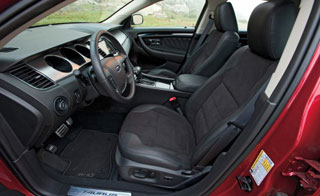
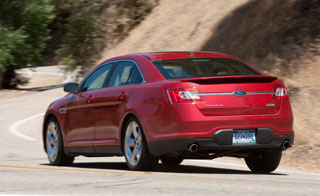
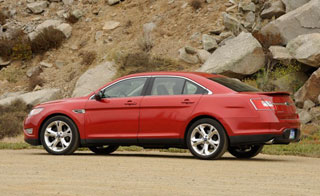
Jonathan Elfalan and Tom Wilson
A source: Road and Track

